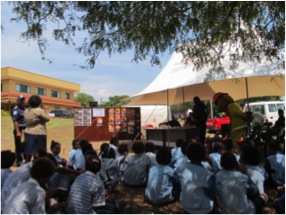 The International Disaster Risk Reduction Day in Papua New Guinea was marked at a special event organised by the National Disaster Centre of Papua New Guinea and supported by United Nations Development Programme (UNDP) and Secretariat of the Pacific Community (SPC).
The International Disaster Risk Reduction Day in Papua New Guinea was marked at a special event organised by the National Disaster Centre of Papua New Guinea and supported by United Nations Development Programme (UNDP) and Secretariat of the Pacific Community (SPC).
Representatives from key National Government Departments, I/NGOs and Donor partners, UN agencies attended the commemoration ceremony. School children from four schools in Port Moresby also attended the commemoration ceremony.
October 13 each year marks the United Nations International Day for Disaster Reduction (IDDR). The day forms part of the global awareness campaign to raise awareness of disaster risk reduction, spark public interest and ultimately help prevent, reduce and minimise loss and damage from disasters.
This year’s theme focused on children and youth as enablers of disaster risk reduction. The objective is to promote the role of children and youth in DRR and to advocate for greater support and information they need to become participants, decision makers and implementers of DRR.
Welcoming the guests to the ceremony Mr. Martin Mose, Acting Director, National Disaster Centre said “As we all know, due to its unique geo-climatic conditions and location in the Pacific Ring of Fire, Papua New Guinea (PNG) is prone to a various natural hazards. PNG is one of the most hazard prone countries in the Pacific. The Government of PNG recognizes the country’s vulnerability to natural disasters and is committed to reducing disaster risk. We also recognize that the youth and children are one of the most vulnerable groups and at the same time they have a significant role to play in environmental resources management and disaster risk reduction (DRR)”. The Acting Director also added that ‘We have been working with Department of Education in the development of a Policy to reduce disaster risks in Education Sector. One of the policy recommendations is to enhance disaster preparedness at school levels through awareness campaigns and school based disaster contingency Plans. We are also exploring the possibilities to include Disaster Risk Reduction in the school curriculum so that every student is aware of disasters and ways to manage and mitigate disaster risks’.
Speaking on behalf of the United Nations, Mr. Jorg Schimmel from UNDP remarked that studies have indicated that children and youth represent more than half of the population affected by Disasters. Worldwide some 66 million children are affected by disasters every year. This confirms that they are one of the most vulnerable groups to disaster. Effective risk management must involve those most at risk but often their involvement in risk reduction is overlooked. Hence it is crucial that there should be systematic efforts to involve children and youth in disaster risk reduction activities. This will not only reduce their vulnerability to disasters but also ensure that they play an active role in disaster mitigation and preparedness. Mr. Jorg Schimmel also stressed that It is time to step up to the challenge and involve the children and youth in the efforts for Disaster Risk Reduction by educating and informing children and youth that disaster risk reduction is also their concern and by enhancing partnerships among governments, children and youth-led organizations, local governments, academia, civil society organizations, the private sector, the media and the UN system, to enhance commitment and support for children and youth inputs to DRR.
In his key note address Mr. Russel Ikosi, Acting Secretary, Department of Provincial and Local level Government, remarked that although children and youth are often portrayed as victims of disaster and climate change it is about time that Children and youth should be encouraged to participate in disaster risk reduction and decision making. The children and the youth are the future of humanity and are tomorrow’s decision makers hence it is essential to include them in Disaster Risk Reduction. If they are properly educated and informed about risk reduction we can be assured of the fact that we will have a better future.
The International Day for Disaster Reduction has also been marked with launching of the IFRC’s Word Disaster Report in PNG. A number of stalls were put up by government departments and agencies and NGOs showcasing their Disaster Risk Management activities in PNG. The stalls were visited by the general public and school children.
Photo Caption: School children visiting stall put up by PNG Fire Services.





